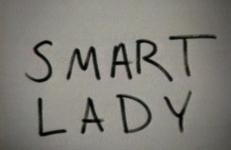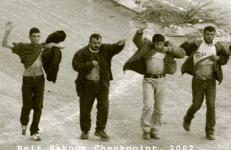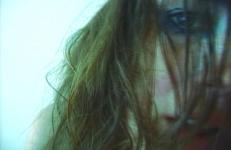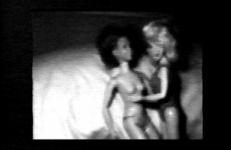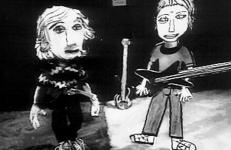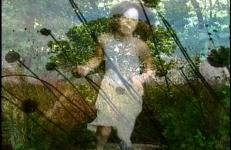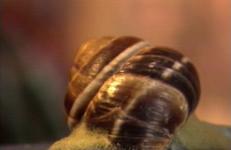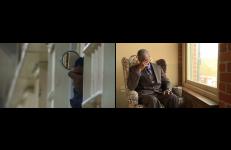Shot in black and white, this rough-and-ready trilogy is about twin sisters who "act out" and act up in their own best interests. At the age when a young girl might discover her own sexuality, they explore themselves (and each other) in "games" and playtime together. In the three sections—"Icky and Kathy Find Liberty", "The Babysitter", and "Learning To Suck"—the girls engage in slightly illicit acts together. Being naughty can be fun!
Youth/Childhood
With wit and humor, seven-year-old Kendra portrays ten female stereotypes, including an ingratiating Southern belle, a motorcycle-riding tough chick, and a simpering housewife. Under the rubric of playing dress-up, the video illustrates the pervasive, prescribed personalities available to women, and the early age at which girls recognize these choices. But, as outtakes reveal, spirited Kendra’s is infinitely more complex than the cardboard cut-outs she depicts.
"It may indeed be questioned whether we have any memories at all from our childhood: memories relating to our childhood may be all that we possess. Our childhood memories show us our earliest years not as they were, but as they appeared at the later periods when the memories were aroused. In these periods of arousal, the childhood memories did not, as people are accustomed to say, emerge; they were formed at that time. And a number of motives, with no concern for historical accuracy, had a part in forming them, as well as in the selection of the memories themselves."
A young girl buys a weird toy from a charity shop. She forms such an intense relationship with it that it develops special ways of communicating and a strange connection to her that seems to defy the laws of physics. As the situation escalates, it seems that repression is the only way forward. First conceived of as a kind of fairy tale that goes wrong, this is a piece about learning the “rules” of grown-up reality and an extrapolation of the consequences of “over-identifying” with toys. A digital video with digital video effects, live-action, and model/object animation.
A meditation on birth, silence and American cinema, sealed with a kiss.
The violent surgical act of a boy’s circumcision is contradicted by the peacefulness of his facial expression. Proud to join the world of men, the boy is trying his best to be brave. Yet can the passage to adulthood be that simple?
This title is only available on Radical Closure.
The repeatedly distorted, primate behaviour of an (ani)female carrying her baby, reflecting the pain and suffering provoked by the mother/child relationship.
Benning gives a chronology of her crushes and kisses, tracing the development of her nascent sexuality. Addressing the camera with an air of seduction and romance, giving the viewer a sense of her anxiety and special delight as she came to realize her lesbian identity.
This title is also available on Sadie Benning Videoworks: Volume 1.
On the vast Kazakhstan Steppes, nine 16-year-olds prepare to graduate from the Akkol orphanage. Rockets launched overhead from the nearby Cosmodrome inspire their dreams as they write about and perform their imagined future-selves. Guided by the nomadic spirit and natural beauty of the Steppes, the teens explore questions of time and truth in relation to the challenging reality of their lives.
These five short videos introduce Judy, a paper maché puppet who ruminates on her position in society. Like Judy, of the famous Punch and Judy puppet duo, Benning’s Judy seems to experience the world from the outside, letting things happen to her rather than making things happen around her.
This title is also available on Sadie Benning Videoworks: Volume 3.
Rosie Cutler, a middle school lunch lady, and TJ Fortune, a outcast student, have an unusual relationship. Mystically-minded and gender ambiguous, TJ recoils into an abandoned warehouse where he builds a massive sculptural shrine from discarded objects and trash. Through a dream Rosie makes intimate contact with a trans-worldly being who she hopes will bridge the gap between real and imagined to reveal truths about our world.
La Mesa explores the intersections of memory, identity and queer desire. It recreates fragmented and romanticized stories of a childhood in rural Mexico as told by the artist’s father. These disjointed vignettes are interwoven with queered reenactments of scenes from popular culture. The artist casts himself in the old Mexican films and American Westerns he grew up watching with his family in California. He appears as the romantic lead opposite the male actors, including Pedro Infante, Mexican national hero and the filmmaker’s childhood crush.
Videotaped on August 13th 1972, this tape features a number of scenes shot for Lanesville TV, including the Videofreex at the Catskill Game Farm shooting footage of the animals. There are some oddball images… a woman on an exercise machine, and someone in a gorilla suit brushing their teeth. A man named Steve Toomie from Tannersville, NY talks about Mountaintop Youth Group’s performances. There is the horse riding competition in Hunter. A little girl asks, “Are you the Lanesville Television guy?” and then shows her horse ribbon to the camera.
In 1995 when TJ Cuthand was 16 they felt like the only lesbian at their Saskatoon high school. This turned out to be untrue, but the lack of visibility in their high school coupled with the lack of representation of Queer teenagers in the 90's made their video, a comedic short about teenage lesbian loneliness and trying to bribe classmates to come out with the promise of candy.
Zaatari’s contribution to Lebanon’s Pavilion at the Venice Biennial 2013. This video offers a portrait of a public school and a tribute to those refusing illegal military orders.
Little Spirits is about a young girl who plays a trick on a friend, unaware or uninterested in the possible consequences.
This title is also available on Cecelia Condit Videoworks: Volume 2
Locke’s Way is the photographic path to knowledge, full of twists and turns, treacherously steep. What has happened down here? A family’s photographs tell us everything and nothing about the subterranean past. "One of the central questions of philosophy has always been: what can be known? Locke’s Way provides a vivid illustration of this perennial philosophical dilemma. In this short video, Donigan Cumming is preoccupied with the story of his older brother, who seems to have been brain-damaged and spent much of his life in institutions.
¡Macho Shogun! was created by Reed Anderson and Daniel Davidson over a single weekend some time in 2000. It's your basic monster-robot / destroy-city kind of video that we wanted to make when we were kids but never did.
This title is only available on Suitable Video, Volume 1.
¡Macho Shogun! was created by Reed Anderson and Daniel Davidson over a single weekend some time in 2000. It's your basic monster-robot / destroy-city kind of video that we wanted to make when we were kids but never did.
This title is only available on Suitable Video, Volume 1.
Magic for Beginners examines the mythologies found in fan culture, from longing to obsession to psychic connections. The need for such connections (whether real or imaginary) as well as the need for an emotional release that only fantasy can deliver is explored.
"Out of the blue, I bought my first television. I kept the TV on all the time."
— Andy Warhol
"Mama mama mama...," a woman calls out again and again, over and over. Is it her child that she mimics, or is she calling for her own mother? A desperate video performance in the first person.
We recently went to Guinea Bissau to research the guerrilla schools of the mangroves. Instead, we soon became ourselves the apprentices and the first lesson we had to learn was how to walk. If you walk straight, placing your heels on the ground first, you promptly slip and fall in the dams of the flooded mangrove rice field or you get stuck in the mangrove mud. You need to lower your body, flex your knees and stick your toes vertically into the mud, extend your arms forwards in a conscious and present movement. In the mangrove school the learning happens with the whole body.
We recently went to Guinea Bissau to research the guerrilla schools of the mangroves. Instead, we soon became ourselves the apprentices and the first lesson we had to learn was how to walk. If you walk straight, placing your heels on the ground first, you promptly slip and fall in the dams of the flooded mangrove rice field or you get stuck in the mangrove mud. You need to lower your body, flex your knees and stick your toes vertically into the mud, extend your arms forwards in a conscious and present movement. In the mangrove school the learning happens with the whole body.
Segalove re-enacts the trials and travails of her desperate, hormonal, pubescent years with actors dancing their way through what looks like a techni-color version of the Cleaver’s backyard. She plays herself, getting questionable advice from girlfriends, begging her mother for a bra and falling in love for the first time, with Moondoggie in Gidget Goes Hawaiian.
Natural Life is a feature-length experimental documentary challenging inequities in the U.S. juvenile justice system by depicting, through documentation and reenactment, the stories of five individuals who were sentenced to Life Without Parole (Natural Life) for crimes they committed as youth.
The youthful status and/or lesser culpability of these youths, their backgrounds, and their potential for rehabilitation were not taken into account at any point in the charging and sentencing process. The five will never be evaluated for change, difference or growth. They will remain in prison till they die.





